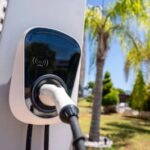Introduction to Home EV Charging
As a leading EV charger manufacturer in China, LiCB Charge offers reliable AC and DC electric vehicle charging stations along with comprehensive charging solutions to meet your needs.
As more drivers make the shift from gasoline-powered cars to electric vehicles (EVs), home charging becomes a key advantage. It offers the convenience of charging at home, saving money, and reducing your reliance on public charging stations. But how does it work? This guide breaks down everything you need to know about home EV charging, including the types, installation, speeds, and future technologies.
How to Charge an Electric Car at Home
1. Level 1 Charging (120V – Slow but Simple)
Level 1 charging uses a standard 120-volt household outlet, which means no extra installation. While this method is the easiest, it’s also the slowest, adding only 3 to 5 miles of range per hour. Ideal for plug-in hybrid electric vehicles (PHEVs) or drivers with short daily commutes.
-
Charging Speed: Adds 3–5 miles of range per hour (full charge may take 24+ hours).
-
Best For: PHEVs or EVs with short trips.
-
Pros: No installation required, works anywhere with an outlet.
-
Cons: Too slow for most full-electric vehicles.
2. Level 2 Charging (240V – Faster & More Efficient)
Level 2 charging requires a 240-volt outlet, similar to those for appliances like dryers. It charges EVs much faster—adding 15 to 30 miles of range per hour. While it requires professional installation, it’s well worth the cost for full EV owners and those with longer commutes.
-
Charging Speed: Adds 15–30 miles of range per hour (full charge in 4-8 hours).
-
Best For: Full-electric vehicles and long commutes.
-
Pros: Much faster than Level 1, more convenient for daily use.
-
Cons: Requires installation (costs vary).
Choosing Between a 240V Outlet vs. Dedicated Charger
| Feature | 240V Outlet | Dedicated EV Charger |
|---|---|---|
| Speed | Up to 7.4 kW | Up to 19.2 kW (faster) |
| Installation Cost | $300–$1,500 | $500–$2,000+ |
| Smart Features | No | Yes (Wi-Fi, scheduling, etc.) |
| Portability | Yes (with adapter) | No (fixed installation) |
Most EV owners prefer a dedicated Level 2 charger for its speed, extra features, and better performance.
Installing a Home EV Charger: Costs & Considerations
1. Electrical Requirements
Your home’s electrical system must have enough capacity for a Level 2 charger. Older homes may need upgrades to the electrical panel.
2. Installation Costs
-
Basic installation (existing 240V line): $250–$800
-
Complex installation (new wiring & panel upgrade): $1,500–$3,000+
Some states offer rebates or tax credits to help reduce costs, like the U.S. federal tax credit, which covers 30% of installation costs up to $1,000.
3. Choosing an Installer
Hire a licensed electrician experienced in EV charger installations. It’s a good idea to get multiple quotes and check for any utility company discounts.
How Fast Can You Charge at Home?
Charging speed depends on the charger, the vehicle, and the battery size. Here’s a quick comparison:
| Charger Type | Power Output | Miles Added Per Hour |
|---|---|---|
| Level 1 (120V) | 1.4 kW | 3–5 miles |
| Level 2 (240V, 32A) | 7.7 kW | 25–30 miles |
| Level 2 (240V, 48A) | 11.5 kW | 35–45 miles |
Other factors like your car’s onboard charger and battery size will affect how quickly it charges. For example, a Tesla can handle up to 11.5 kW, while a Nissan Leaf is limited to 6.6 kW.
Cost of Charging at Home
Charging at home is much cheaper than gasoline or public charging stations. For example, a 60 kWh battery costs around $7.20 to fully charge at a rate of $0.12 per kWh. In contrast, a gasoline vehicle getting 30 MPG would cost around $23 to drive the same distance.
Advanced EV Charging: V2L & V2G
1. Vehicle-to-Load (V2L) – Using Your EV as a Power Bank
Certain EVs like the Ford F-150 Lightning can provide power to devices through bidirectional charging, useful for emergency backup, outdoor events, and worksite tools.
2. Vehicle-to-Grid (V2G) – Sending Energy Back to the Grid
Some EVs, such as the Nissan Leaf, can return energy to the grid during peak demand, earning utility credits and helping stabilize the grid. While this technology is still in its early stages, it offers great potential for turning EVs into mobile energy storage.
Is Home EV Charging Right for You?
Pros of Home Charging:
-
Convenience: Wake up to a full charge every day.
-
Cost savings: Cheaper than gas and public charging stations.
-
Energy independence: No more visits to the gas station.
-
Future-ready: Bidirectional charging adds extra functionality.
Cons & Challenges:
-
Upfront costs: Installation can be pricey.
-
Renters: May need landlord approval to install a charger.
-
Home upgrades: Older homes may need electrical upgrades, which can add to the cost.
The Future of Home EV Charging
The future of home EV charging looks promising with innovations on the horizon:
-
Smart Chargers: These will allow you to optimize your charging schedule and track energy usage.
-
Wireless Charging: Though still emerging, wireless charging could make plugging in your EV a thing of the past.
-
Solar Integration: Pairing your home charger with solar panels will further reduce environmental impact and energy costs.
Conclusion
Home EV charging is a game-changer for electric vehicle owners, offering unmatched convenience and long-term savings. By understanding your options, installation requirements, and future advancements, you can make a decision that suits your needs and supports a greener future.
Should You Charge at Home?
If you own or plan to buy an EV, home charging is likely the best option for you. While installation can be costly, the convenience and savings over time make it worthwhile.
Next Steps:
-
Check your home’s electrical capacity.
-
Get quotes from certified installers.
-
Look for rebates and incentives.
With the right setup, you’ll enjoy cheaper, greener, and hassle-free driving for years to come.Know more about Google SEO Directory




